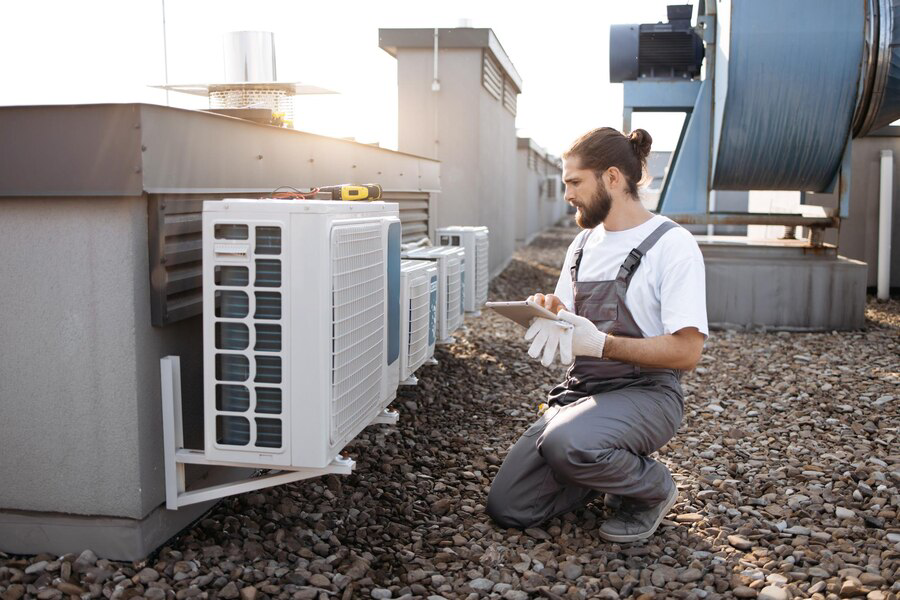In the realm of architectural design and construction, few elements are as crucial as the HVAC (Heating, Ventilation, and Air Conditioning) system. It’s the invisible force shaping our indoor environments, regulating temperature, humidity, and air quality to create comfortable and healthy spaces. The HVAC Designers’ Handbook stands as a beacon for architects, engineers, and designers navigating the intricate maze of HVAC systems. Crafted with meticulous detail and expertise, this handbook is more than just a guide; it’s a companion through the complex process of designing and implementing optimal climate control solutions. From understanding the fundamentals of thermodynamics to mastering the latest technological advancements, this handbook offers a comprehensive roadmap. With insights from seasoned professionals and industry best practices, it equips practitioners with the knowledge and tools to craft environments that seamlessly blend comfort, efficiency, and sustainability. Welcome to a world where every breath is a testament to thoughtful design and engineering precision.
Fundamentals of HVAC Systems: Understanding the Basics
In grasping the fundamentals of HVAC systems, one delves into the cornerstone principles governing the manipulation of indoor climate. It encompasses the core components and functionalities of heating, ventilation, and air conditioning systems, elucidating the intricate interplay between them. Understanding the basics involves familiarizing oneself with concepts like air circulation, temperature regulation, and humidity control. From the rudimentary understanding of HVAC terminology to the comprehension of system layouts and configurations, this foundational knowledge forms the bedrock upon which advanced design and implementation strategies are built, ensuring the seamless orchestration of comfort and efficiency within built environments.

Principles of Heat Transfer and Thermodynamics
Understanding the principles of heat transfer and thermodynamics is fundamental in HVAC design, shaping the efficiency and effectiveness of heating, ventilation, and air conditioning systems. At its core, this knowledge delves into the movement of heat energy within spaces, governed by laws of conduction, convection, and radiation. Mastery of these principles empowers engineers to optimize system performance, accurately calculate heat loads, and select appropriate equipment. By integrating thermodynamic concepts, designers can create HVAC solutions tailored to specific environmental requirements, ensuring comfort and functionality in diverse settings.
- Conduction: The transfer of heat through direct contact between materials.
- Convection: The movement of heat through fluid circulation, such as air or water.
- Radiation: The emission of heat energy in the form of electromagnetic waves.
- Heat Loads: Calculating the amount of heat energy required to maintain desired indoor conditions.
- Equipment Selection: Choosing HVAC components and systems based on thermodynamic principles and efficiency standards.
A deep understanding of heat transfer and thermodynamics is indispensable for HVAC professionals, shaping the design and performance of systems that regulate indoor environments. By applying these principles judiciously, designers can create solutions that prioritize comfort, efficiency, and sustainability.
Ventilation Strategies: Enhancing Indoor Air Quality
In the pursuit of healthier indoor environments, ventilation strategies emerge as paramount considerations in HVAC design. Ventilation not only ensures the supply of fresh outdoor air but also facilitates the removal of indoor pollutants, allergens, and odors, thereby enhancing indoor air quality. Understanding ventilation dynamics involves evaluating factors such as air exchange rates, filtration mechanisms, and the strategic placement of intake and exhaust vents. By incorporating advanced ventilation techniques such as demand-controlled ventilation and energy recovery systems, designers can optimize air quality while minimizing energy consumption, fostering environments conducive to well-being and productivity.
Design Considerations for Heating Solutions
Designing heating solutions involves a meticulous approach to ensure optimal comfort and energy efficiency in indoor spaces, particularly in colder climates. From assessing heating loads to selecting appropriate equipment, several key considerations influence the effectiveness of heating systems.
- Heating Load Assessment: Understanding the specific heating requirements of a space based on factors such as size, insulation, and occupancy.
- Equipment Selection: Choosing heating equipment tailored to the heating load and environmental conditions, whether it’s radiant floor heating, forced-air systems, or heat pumps.
- Thermal Distribution Systems: Designing efficient distribution systems to ensure even heat distribution throughout the space, minimizing energy loss.
- Energy Efficiency Measures: Incorporating energy-efficient technologies and practices to reduce energy consumption and operating costs.
- Environmental Impact: Considering the environmental impact of heating solutions and prioritizing sustainable options to minimize carbon footprint.
Designing heating solutions requires a comprehensive approach that considers factors such as heating load assessment, equipment selection, thermal distribution systems, energy efficiency measures, and environmental impact. By prioritizing these considerations, designers can create heating systems that provide optimal comfort while minimizing energy consumption and environmental footprint.
Cooling Technologies: From Traditional to Innovative Approaches
Cooling technologies have witnessed a remarkable evolution, from traditional methods like natural ventilation and evaporative cooling to modern innovations such as air conditioning and heat pumps. Understanding the diverse range of cooling options involves evaluating factors such as climate conditions, building orientation, and occupant comfort preferences. Designers must assess the efficiency, reliability, and environmental impact of cooling systems while balancing initial costs with long-term operational benefits. By leveraging advanced cooling technologies like variable refrigerant flow systems and chilled beam systems, designers can create indoor environments that remain cool, comfortable, and energy-efficient even in the face of rising temperatures and changing climate patterns.

Energy Efficiency and Sustainability in HVAC Design
In today’s era of environmental consciousness, energy efficiency and sustainability are paramount considerations in HVAC design. By implementing green practices and innovative technologies, HVAC systems can significantly reduce energy consumption and environmental impact while maintaining optimal comfort levels. Here’s a brief overview of key aspects in energy-efficient and sustainable HVAC design:
- Passive Solar Design: Harnessing the power of sunlight through strategic building orientation and design features to minimize the need for mechanical heating and cooling.
- High-Efficiency Equipment: Utilizing energy-efficient HVAC equipment, such as heat pumps, variable-speed air handlers, and condensing boilers, to optimize performance and reduce energy waste.
- Building Envelope Optimization: Enhancing insulation, air sealing, and thermal performance of the building envelope to minimize heat loss in winter and heat gain in summer, resulting in reduced HVAC load.
- Life Cycle Analysis: Conducting comprehensive life cycle assessments to evaluate the environmental impact of HVAC systems from manufacturing and installation to operation and disposal.
- Green Building Standards: Adhering to green building certifications like LEED (Leadership in Energy and Environmental Design) to ensure compliance with rigorous sustainability criteria and promote resource-efficient design.
Prioritizing energy efficiency and sustainability in HVAC design not only reduces operational costs but also contributes to a healthier environment and enhances overall building performance. By embracing these principles, we can create HVAC systems that deliver superior comfort, minimize carbon footprint, and pave the way for a greener, more sustainable future.
Integration of Smart Technologies: Building for the Future
The advent of smart technologies has revolutionized the field of HVAC design, offering unprecedented levels of control, automation, and efficiency. Integration of smart sensors, Internet of Things (IoT) devices, and predictive analytics enables real-time monitoring and optimization of HVAC systems. Designers leverage building management systems (BMS) to orchestrate heating, cooling, and ventilation operations based on occupancy patterns, weather forecasts, and indoor air quality metrics. Moreover, the integration of artificial intelligence (AI) algorithms facilitates predictive maintenance, fault detection, and energy optimization, ensuring optimal system performance and longevity. By embracing smart technologies, designers pave the way for a future where buildings are not just structures but intelligent, adaptive ecosystems that prioritize comfort, sustainability, and occupant well-being.
Conclusion
The HVAC industry is evolving rapidly, driven by advancements in technology and a growing emphasis on sustainability and efficiency. From understanding the basics of HVAC systems to integrating smart technologies for future-proof designs, every aspect plays a crucial role in crafting ideal indoor climates. As we navigate this dynamic landscape, it’s essential to stay informed and collaborate with experts who possess the knowledge and expertise to optimize HVAC solutions effectively. For those seeking excellence in HVAC design and implementation, companies like Best By Farr LLC in Cottonwood, AZ, offer unparalleled service and expertise. Contact them today at (928) 282-2250 to embark on your journey towards creating optimal indoor environments that prioritize comfort, sustainability, and innovation. Let’s build a future where every breath is a testament to thoughtful design and engineering precision.


